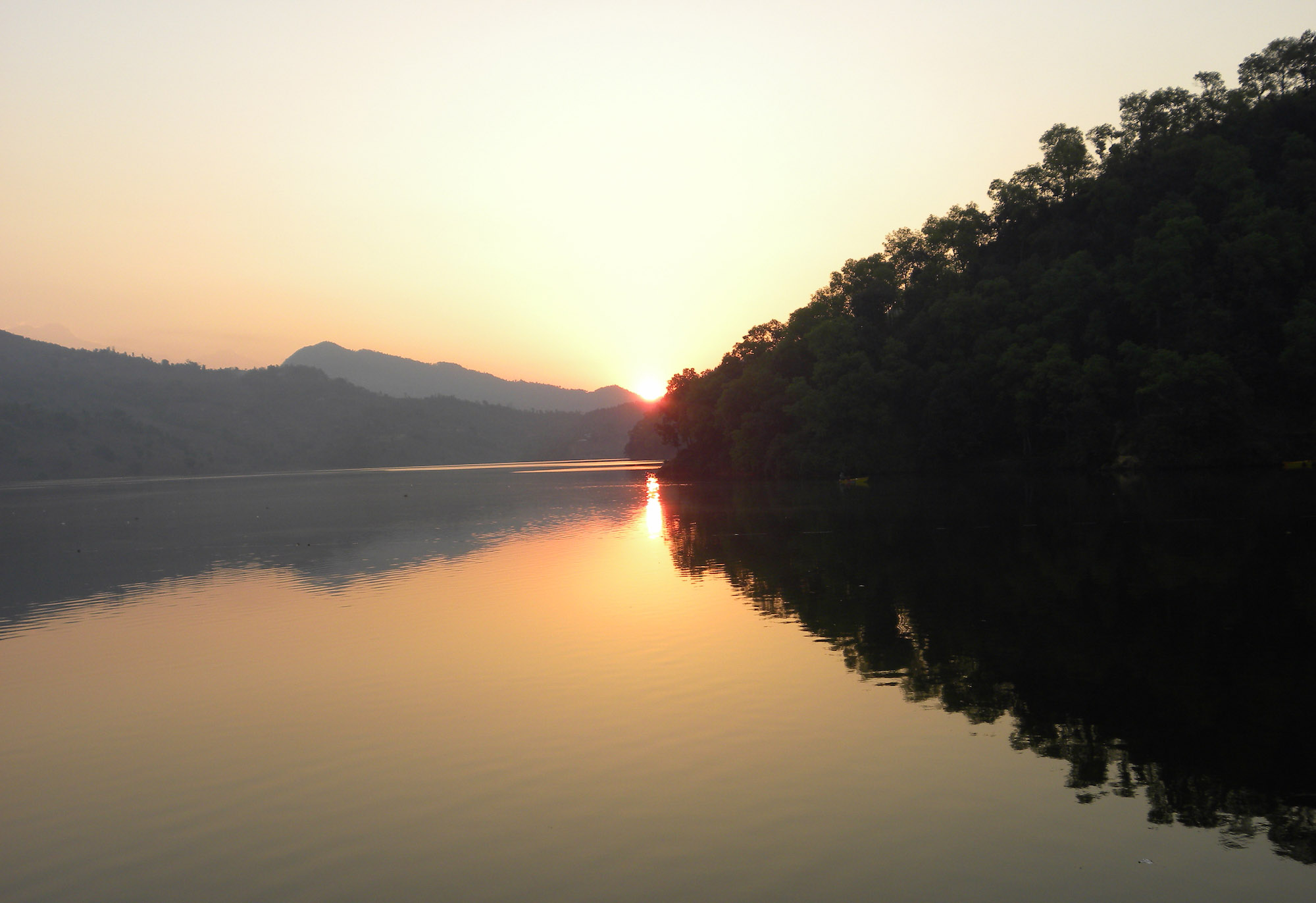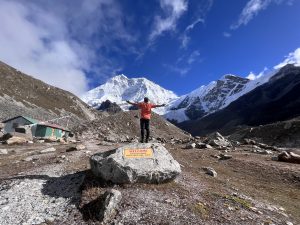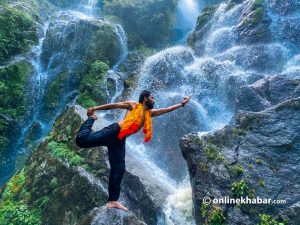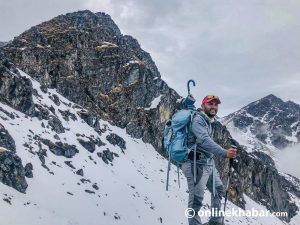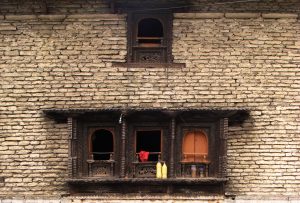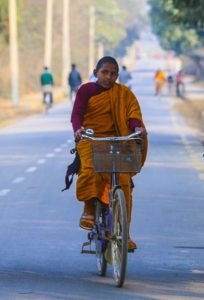I woke up, walked out of my hotel and seemed to have entered right into a Zen painting.
Begnas’s inky waters stretched into the distance like a huge sheet of satin. On it and all around it, it was all silhouettes and silence.
The fluid sound of oars entering, caressing and leaving the water rose as fishermen moved to another spot. When they stopped, silence gushed in. Then another sound as a fishing net landed on the water. The fishermen pulled in the net deftly, determined not to let fish or sound escape.
Equally deftly an invisible hand was pulling the cloak of darkness away from the land. The hills in the east were beginning to turn blue. Another morning was coming to Begnas Tal.
Begnas Tal is cut off from the tide of noise and excitement that floods into any place worthy of being in guidebooks and tourist maps.
When the sun came up from a cleft between the hills in the east, molten gold seemed to have spilled into the lake. A perfect cone appeared behind the hills—Machhapuchhre. Eagles and Egyptian vultures wheeled above the paddy fields. I kept imagining Pokhara’s Lakeside. It felt like in Begnas I had found the lost paradise that was Pokhara.
Shops here are limited to a handful of peddlers selling trinkets from a backpack or displaying their ware on a sheet on the lake’s shore.
Begnas Tal is cut off from the tide of noise and excitement that floods into any place worthy of being in guidebooks and tourist maps. Although this lake does see a lot of visitors as the day progresses, it never degrades into something that necessitates an escape. Shops here are limited to a handful of peddlers selling trinkets from a backpack or displaying their ware on a sheet on the lake’s shore. A wayward cab or motorbike honks its horn once in a while. Otherwise, pressure cookers whistles and eagle calls fill the air.
Begnas gets a little noisy once every morning. That is when the day’s catch is brought to the shop. A small crowd gathers there, hollering, pointing, watching their buys being gutted and cleaned. Some of them come all the way from Pokhara to buy fresh fish. Equally restless are the eagles perched on trees near the shop, trilling in anticipation of the meal of fish innards that will be their breakfast. Nearby, on the edges of artificial ponds where fish are raised, egrets stood transfixed, poised to strike.
Others liked to do their own catching. Walking along the southern shore of the lake, I came upon several men squatting. Fishing lines wrapped around Pepsi bottles and corn cobs rested at their feet. Once in a while one of them hauled out a fish—a little excitement, then another spell of silence. There was a plethora of activities to do around Begnas Tal. But no matter what you did, silence and stillness seemed a prerequisite.
Lured by the houseless, forested hills and the mountains beyond them, I went up the stony trail that wove up from the southwestern corner of the lake. Within moments I was in another world. Closely packed sal trees hid the lake. The forest floor was a crispy carpet of leaves, making walking silently impossible. In the quiet of morning this crunching was loud enough to spook Kalij pheasants, many of whom burst out in flights, emitting frantic alarm calls.
From a few places on the trail, hidden corners of the lake came into view through a gap between the trees; then, the trail changed slightly, and the lake was gone.
A short walk away from Begnas Tal was like a discovery to an outsider like me. I came upon tiny ponds nestled in the folds of hills. Going up the road from the main bazaar, I came suddenly to a temple that offered splendid views of the mountains and lake. And I could take any of the countless trails skirting the lake and I’d be rewarded with solitude.
I often wondered how Begnas Tal had managed to retain its original beauty and quaintness despite being a mere 15 kilometers from Pokhara. And I feared that I’d return to it one day to find it turned into a replica of Pokhara’s Lakeside.
I often wondered how Begnas Tal had managed to retain its original beauty and quaintness despite being a mere 15 kilometers from Pokhara. And I feared that I’d return to it one day to find it turned into a replica of Pokhara’s Lakeside, all glitzy with shops and restaurants and noisy with honking vehicles. But there was time before Begnas became another paradise that was lost to development. There would be at least one more morning of silhouettes and silence, of a stillness that is remembered long after the place where it was encountered has changed unrecognisably.
Checklist
Getting There

Buses leave every fifteen minutes or so from Prithvi Chok in Pokhara for Begnas. Cycling is also a rewarding, if slightly taxing, way of getting from Pokhara to Kathmandu. If you’re coming from Kathmandu, ask your bus driver to drop you off at the crossroads to Lekhnath VDC. From there you can get on the bus coming from Pokhara.
While you are there

The area surrounding the 3.6 square kilometer expanse of Begnas Tal is a place to rejuvenate both body and mind. Whether you prefer to be on land or water, like walks or whiling away time doing nothing in particular, love forests or mountains, Begnas has what you wish for.
Walks
Nothing beats early morning walks along the shore of Begnas. If you’re walking while it’s still dark, go for a walk on the dyke. Perhaps you can talk a fisherman into letting you accompany him on a fishing trip. Sunrise and sunsets on the lake are surreal.
It’s possible to do a complete circuit of the lake, but the trails are not well maintained. And it would take hours to complete a round. The best short walks are east and west of the boat dock; the western trail will take you into sal forests, while the eastern one passes along the lake.
Picnics
There are numerous places on the trails around Begnas that offer ideal spots for a picnic. The southern side is best as it offers plenty of shade and wonderful views of the mountains.
Cycling
Although the trails around the lake are perhaps too risky for all but the most skilled mountain bikers, there are other places for cycling. The paved road up from the main bazaar is a taxing climb but will reward with an unforgettable panorama of Begnas and the snowy peaks. A trail also runs west from the main bazaar, turns towards Begnas and joins the dyke, completing the loop via the boat dock.
Boating
Boat rides is a wonderful way to take in the beauty of the lake and its surroundings. It’s best to go on rides either early in the morning or late in the evening. At these times, the mellow light bathes the lake surface in splendid hues.
Places to Stay

Most places offering lodging are located near the boat dock, which is a five-minute walk from the bus park in Begnas Bazar. The Grand Hotel Begnas has spacious and clean rooms and a rooftop restaurant. Places with simpler amenities but stellar views are clustered on the bluff above the southwestern corner of the lake. For those of you with deep pockets, head to Begnas Lake Resort on the eastern shore.
***
Also read



